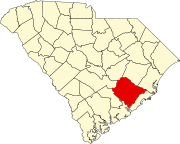
Moncks Corner, South Carolina

Moncks Corner, South Carolina | |
|---|---|
 Depot in Moncks Corner | |
| Nickname: "The Lowcountry's Hometown" | |
 Location of Moncks Corner, South Carolina | |
| Coordinates: 33°12′N 80°0′W / 33.200°N 80.000°W | |
| Country | United States |
| State | South Carolina |
| County | Berkeley |
| Government | |
| • Type | Mayor–council |
| • Mayor | Thomas Hamilton |
| Area | |
• Total | 11.50 sq mi (29.79 km2) |
| • Land | 11.37 sq mi (29.46 km2) |
| • Water | 0.13 sq mi (0.33 km2) |
| Elevation | 52 ft (16 m) |
| Population | |
• Total | 13,297 |
| • Density | 1,169.17/sq mi (451.41/km2) |
| Time zone | UTC−5 (Eastern (EST)) |
| • Summer (DST) | UTC−4 (EDT) |
| ZIP codes | 29430, 29461 |
| Area code(s) | 843, 854 |
| FIPS code | 45-47275[4] |
| GNIS feature ID | 1246709[5] |
| Website | www |
Moncks Corner is a town in and the county seat of Berkeley County, South Carolina, United States.[6] The population was 7,885 at the 2010 census.[7] As defined by the U.S. Census Bureau, Moncks Corner is included within the Charleston-North Charleston, SC Metropolitan Statistical Area.

History
Settled by indigenous peoples for thousands of years, the area of Moncks Corner was occupied by the historic Edistow people, a sub-tribe of the Cusabo tribes. Its various bands shared a language distinct from that of the major language families in the present-day state: Algonquian, Siouan, and Iroquoian, including Cherokee. Although now extinct as a tribe, Etiwan, Edisto, Cherokee, and Catawba descendants make up the eight families of the Wassamasaw Tribe of Varnertown Indians, a community located between Moncks Corner and Summerville. The 1,500-member tribe were recognized by the state as an Indian Tribe in 2009.[8][9]

During the colonial era, Moncks Corner became a major settlement area of French Protestant Huguenots, who came to South Carolina between 1684 and 1688 as refugees due to religious persecution in France.[10] Many family surnames in Berkeley and adjacent counties are of French origin. The Huguenots soon began to intermarry with the English colonists.

The town of Moncks Corner dates back to 1728 and is named for landowner Thomas Monck, a slaveholder who branded his runaway slaves on their chest with his name "T Monck."[11][12] The town began as a trading post with a few taverns and stores. The Battle of Monck's Corner was fought here in 1780, associated with the Siege of Charleston.[13]


The Northeastern Railroad, which ran between Charleston, South Carolina, and Siler City, North Carolina, laid its tracks in 1856, and the train depot became the center of the new town of Moncks Corner. The town of Moncks Corner was chartered on December 26, 1885, and incorporated December 15, 1909.

Moncks Corner was granted the trademark "Capital of Santee Cooper Country" by the South Carolina Secretary of State September 9, 1999, and again October 21, 2004. The trademark is a symbol of its abundant outdoor activities, such as horseback riding, hiking, water sports, boating and freshwater fishing. Moncks Corner is also the home of Santee Cooper's corporate office complex.

The Biggin Church Ruins, Cooper River Historic District, Lewisfield Plantation, Mulberry Plantation, Santee Canal, and Strawberry Chapel and Childsbury Town Site are listed on the National Register of Historic Places.[14]

Geography
Moncks Corner is located near the center of Berkeley County at 33°12′N 80°0′W / 33.200°N 80.000°W (33.1966, -80.0067).[15] Its boundary extends east to the West Branch of the Cooper River, 3 miles (5 km) south of the outlet of Lake Moultrie.

US 52 is the main highway through the town, leading south 32 miles (51 km) to Charleston and north 80 miles (130 km) to Florence. US 17 Alt also passes through the town, leading east 49 miles (79 km) to Georgetown and southwest 16 miles (26 km) to Summerville. SC 6 leads northwest from Moncks Corner along the south and west sides of Lakes Moultrie and Marion 39 miles (63 km) to I-95 at Santee.

According to the United States Census Bureau, Moncks Corner has a total area of 7.4 square miles (19.2 km2), of which 7.3 square miles (18.9 km2) is land and 0.12 square miles (0.3 km2), or 1.81%, is water.[7]

Climate
Moncks Corner is a humid subtropical climate(Cfa) according to the Köppen climate classification system. It is similar to Charleston in regards of the said climate, which Moncks Corner is a suburb of. However, due to the distance from the coast compared to Charleston, it is noticeably hotter in the summer.

| Climate data for Moncks Corner, South Carolina (1991–2020 Normals, extremes 1994–present) | |||||||||||||
|---|---|---|---|---|---|---|---|---|---|---|---|---|---|
| Month | Jan | Feb | Mar | Apr | May | Jun | Jul | Aug | Sep | Oct | Nov | Dec | Year |
| Record high °F (°C) | 83 (28) |
87 (31) |
90 (32) |
92 (33) |
102 (39) |
102 (39) |
104 (40) |
105 (41) |
97 (36) |
98 (37) |
89 (32) |
83 (28) |
105 (41) |
| Mean maximum °F (°C) | 76.6 (24.8) |
78.7 (25.9) |
84.2 (29.0) |
89.3 (31.8) |
94.1 (34.5) |
98.8 (37.1) |
99.7 (37.6) |
99.4 (37.4) |
94.9 (34.9) |
89.7 (32.1) |
83.5 (28.6) |
78.9 (26.1) |
100.9 (38.3) |
| Mean daily maximum °F (°C) | 58.7 (14.8) |
61.8 (16.6) |
68.7 (20.4) |
77.5 (25.3) |
84.3 (29.1) |
89.9 (32.2) |
93.1 (33.9) |
91.1 (32.8) |
86.0 (30.0) |
77.6 (25.3) |
68.3 (20.2) |
61.0 (16.1) |
76.5 (24.7) |
| Daily mean °F (°C) | 48.6 (9.2) |
51.1 (10.6) |
57.3 (14.1) |
65.4 (18.6) |
73.3 (22.9) |
80.1 (26.7) |
83.4 (28.6) |
81.8 (27.7) |
76.7 (24.8) |
67.2 (19.6) |
57.4 (14.1) |
50.9 (10.5) |
66.1 (19.0) |
| Mean daily minimum °F (°C) | 38.4 (3.6) |
40.5 (4.7) |
45.9 (7.7) |
53.2 (11.8) |
62.4 (16.9) |
70.3 (21.3) |
73.7 (23.2) |
72.4 (22.4) |
67.4 (19.7) |
56.8 (13.8) |
46.5 (8.1) |
40.8 (4.9) |
55.7 (13.2) |
| Mean minimum °F (°C) | 20.4 (−6.4) |
25.9 (−3.4) |
30.1 (−1.1) |
37.9 (3.3) |
47.6 (8.7) |
59.6 (15.3) |
65.4 (18.6) |
65.3 (18.5) |
56.2 (13.4) |
41.5 (5.3) |
29.9 (−1.2) |
26.2 (−3.2) |
19.6 (−6.9) |
| Record low °F (°C) | 13 (−11) |
11 (−12) |
20 (−7) |
30 (−1) |
40 (4) |
48 (9) |
58 (14) |
55 (13) |
45 (7) |
30 (−1) |
22 (−6) |
15 (−9) |
11 (−12) |
| Average precipitation inches (mm) | 3.66 (93) |
3.44 (87) |
3.49 (89) |
3.03 (77) |
3.56 (90) |
5.42 (138) |
6.76 (172) |
6.25 (159) |
5.82 (148) |
4.10 (104) |
2.87 (73) |
3.92 (100) |
52.32 (1,330) |
| Average precipitation days | 8.8 | 9.1 | 8.3 | 7.7 | 8.2 | 10.4 | 11.9 | 11.9 | 8.9 | 7.5 | 7.4 | 9.6 | 109.7 |
| Source: NOAA (mean maxima/minima 2006–2020)[16][17] | |||||||||||||
Demographics
| Census | Pop. | Note | %± |
|---|---|---|---|
| 1890 | 118 | — | |
| 1900 | 202 | 71.2% | |
| 1910 | 232 | 14.9% | |
| 1920 | 309 | 33.2% | |
| 1930 | 623 | 101.6% | |
| 1940 | 1,165 | 87.0% | |
| 1950 | 1,818 | 56.1% | |
| 1960 | 2,030 | 11.7% | |
| 1970 | 2,314 | 14.0% | |
| 1980 | 4,179 | 80.6% | |
| 1990 | 5,607 | 34.2% | |
| 2000 | 5,952 | 6.2% | |
| 2010 | 7,885 | 32.5% | |
| 2020 | 13,297 | 68.6% | |
| U.S. Decennial Census[18][3] | |||
2020 census
| Race | Num. | Perc. |
|---|---|---|
| White (non-Hispanic) | 7,297 | 54.88% |
| Black or African American (non-Hispanic) | 4,397 | 33.07% |
| Native American | 59 | 0.44% |
| Asian | 169 | 1.27% |
| Pacific Islander | 10 | 0.08% |
| Other/Mixed | 634 | 4.77% |
| Hispanic or Latino | 731 | 5.5% |
As of the 2020 United States census, there were 13,297 people, 3,774 households, and 2,796 families residing in the town.

2000 census
As of the census[4] of 2000, there were 5,952 people, 2,103 households, and 1,491 families residing in the town. The population density was 1,333.1 inhabitants per square mile (514.7/km2). There were 2,334 housing units at an average density of 522.8 per square mile (201.9/km2). The racial makeup of the town was 57.33% White, 36.59% African American, 0.64% Native American, 0.55% Asian, 0.05% Pacific Islander, 2.97% from other races, and 1.86% from two or more races. Hispanic or Latino of any race were 4.20% of the population.

There were 2,103 households, out of which 40.6% had children under the age of 18 living with them, 43.6% were married couples living together, 23.1% had a female householder with no husband present, and 29.1% were non-families. 25.6% of all households were made up of individuals, and 9.6% had someone living alone who was 65 years of age or older. The average household size was 2.61 and the average family size was 3.09.

In the town, the population was spread out, with 28.9% under the age of 18, 10.5% from 18 to 24, 30.0% from 25 to 44, 18.1% from 45 to 64, and 12.5% who were 65 years of age or older. The median age was 32 years. For every 100 females, there were 87.5 males. For every 100 females age 18 and over, there were 81.8 males.

The median income for a household in the town was $31,711, and the median income for a family was $37,335. Males had a median income of $30,634 versus $21,796 for females. The per capita income for the town was $15,202. About 16.5% of families and 17.6% of the population were below the poverty line, including 26.6% of those under age 18 and 11.7% of those age 65 or over.

Education
Moncks Corner has a public library, a branch of the Berkeley County Library System.[20]

Notable people
- Omar Brown, National Football League (NFL) player
- Charlamagne tha God (born 1978), radio and TV personality
- Andre Ellington, NFL player
- Bruce Ellington (born 1991), NFL player
- Steven Furtick, pastor of Elevation Church
- Willie J. Hill Jr. (born 1951), bishop of the Reformed Episcopal Church Diocese of the Southeast
- Robin Kenyatta, jazz musician
- Ryan Stewart, NFL player, 2 Live Stews radio personality with brother Doug
- Isaac Wright Jr. (born 1962), lawyer
- Kwame Brown, basketball player
- Kathryn Dennis, reality TV star (Southern Charm)
References
- ^ "Town officials". Town of Moncks Corner. Archived from the original on November 16, 2012. Retrieved February 19, 2013.
- ^ "ArcGIS REST Services Directory". United States Census Bureau. Retrieved October 15, 2022.
- ^ a b "Census Population API". United States Census Bureau. Retrieved October 15, 2022.
- ^ a b "U.S. Census website". United States Census Bureau. Retrieved January 31, 2008.
- ^ "US Board on Geographic Names". United States Geological Survey. October 25, 2007. Retrieved January 31, 2008.
- ^ "Find a County". National Association of Counties. Retrieved June 7, 2011.
- ^ a b "Geographic Identifiers: 2010 Demographic Profile Data (G001): Moncks Corner town, South Carolina". U.S. Census Bureau, American Factfinder. Archived from the original on February 12, 2020. Retrieved April 4, 2014.
- ^ Bo Petersen, "Researchers explore local tribe's ties to legendary temple", The Post and Courier, April 17, 2005, accessed December 14, 2011
- ^ Bo Petersen, "Local tribe reclaims its roots, heritage", April 17, 2005, accessed December 14, 2011
- ^ "Huguenots" in Walter Edgar, ed., The South Carolina Encyclopedia (Columbia: USC Press, 2006)
- ^ Gannett, Henry (1905). The Origin of Certain Place Names in the United States. U.S. Government Printing Office. p. 212.
- ^ Windley, Lathan (2014). A Profile of Runaway Slaves in Virginia and South Carolina from 1730 Through 1787. Routledge.
- ^ Buchanan, John (1997). The Road to Guilford Courthouse. New York: John Wiley & Sons. pp. 60–63. ISBN 9780471327165.
- ^ "National Register Information System". National Register of Historic Places. National Park Service. July 9, 2010.
- ^ "US Gazetteer files: 2010, 2000, and 1990". United States Census Bureau. February 12, 2011. Retrieved April 23, 2011.
- ^ "NOWData – NOAA Online Weather Data". National Oceanic and Atmospheric Administration. Retrieved April 23, 2023.
- ^ "Summary of Monthly Normals 1991–2020". National Oceanic and Atmospheric Administration. Retrieved April 23, 2023.
- ^ "Census of Population and Housing". Census.gov. Retrieved June 4, 2015.
- ^ "Explore Census Data". data.census.gov. Retrieved December 15, 2021.
- ^ "South Carolina libraries and archives". SCIWAY. Retrieved June 7, 2019.
External links
See what we do next...
OR
By submitting your email or phone number, you're giving mschf permission to send you email and/or recurring marketing texts. Data rates may apply. Text stop to cancel, help for help.
Success: You're subscribed now !



